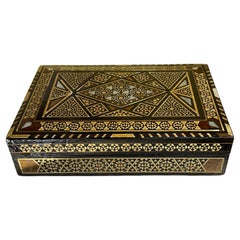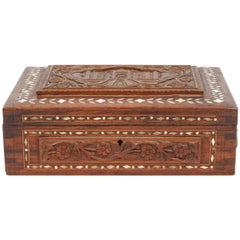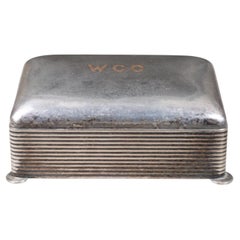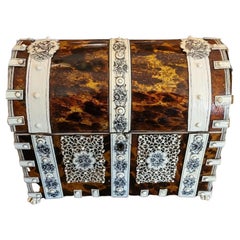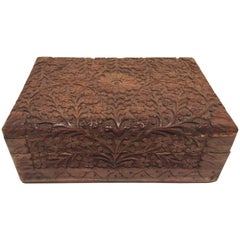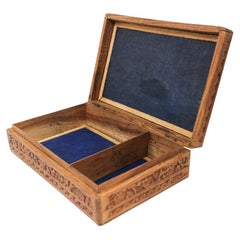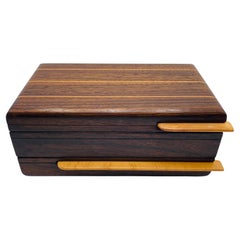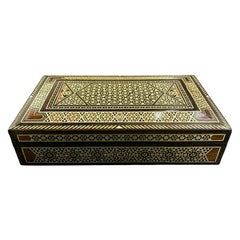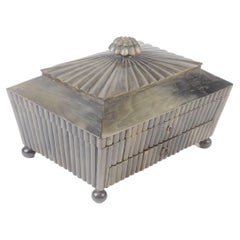Sandalwood Decorative Boxes
to
17
10
7
4
1
1
1
1
46
3,797
3,160
1,167
1,020
16
1
15
14
12
2
2
Height
to
Width
to
17
17
17
3
1
Material: Sandalwood
Middle Eastern Moorish Jewelry Box
Located in Delray Beach, FL
exquisite middle Eastern Moorish Syrian inlay jewelry box. This box is intricately inlaid with Moorish motif designs which have been uniquely inlaid with bone, mother of pearl and f...
Category
20th Century Asian Islamic Sandalwood Decorative Boxes
Materials
Mother-of-Pearl, Sandalwood
19th Century Anglo-Indian Mughal Box
Located in Moreno Valley, CA
19th century Anglo-Indian Mughal wood box, inlaid and hand carved with the Taj Mahal and some flowers all around.
Jewelry box, Anglo-Raj box from India in great condition.
Nice Mughal Bombay Box...
Category
Late 19th Century Indian Anglo Raj Antique Sandalwood Decorative Boxes
Materials
Sandalwood
Art Deco Monogrammed "WCC" Silver Plated Cigarette Box c.1930
By Napier Co.
Located in San Francisco, CA
ABOUT
An original Art Deco silver plated cigarette box monogrammed "WCC" with a Sandalwood insert. Stamped "Napier".
CREATOR The Napier Co.
DATE OF MANUFACTURE c.1930-1940...
Category
Early 20th Century American Art Deco Sandalwood Decorative Boxes
Materials
Silver Plate
19C Anglo Indian Vizagapatam Bone and Shell Domed Stationery Box
Located in Dallas, TX
PRESENTING A LOVELY 19C Anglo Indian Vizagapatam Bone and Shell Domed Stationery Box – ‘Alice’s Box’.
Made in Vizagapatam, India, circa 1860-80.
We call this one: “Alice’s Box”! It has lived ‘a hard, well used and traveled life’, as is evident from the number of losses and repairs, as is obvious from the photos, especially to the faux ivory panels and bands to the top. The bonus to the loss of the frieze panels to the dome has a ‘bonus’, however, as their loss has revealed the most GORGEOUS faux blonde tortoiseshell underneath!
The box is dome/casket shaped.
The top has 3 bands, with the center one being the original. The 2 side bands are later ivorine.
The faux ivory and hand-painted medallions on the domed lid, have been saved and they depict Hindu Gods, Vishnu and Shiva.
The front and side panels are still in pretty good shape and are decorated with lac ink (indelible ink made from crushed beetles) depicting lovely floral designs.
The domed lid open to reveal a series of open compartments for envelopes, writing paper etc. and one lidded panel for stamps.
Inside the box are 2 paper labels: one probably being the original item ticket and the other with:
” Alice’s address is 272 Ashworth Ave, Toronto 4, Ontario”.
Probably, the original owner? Hence, we call it ‘Alice’s Box’.
What a journey/life this box has had!
Made in India, made its way to Canada, back to Ireland and then to Texas!
This is why, WE LOVE ANTIQUES...
Category
19th Century Indian Anglo-Indian Antique Sandalwood Decorative Boxes
Materials
Bone, Shell, Sandalwood
Anglo Raj Hand-Carved Decorative Jewelry Box
By Rajhastani
Located in Moreno Valley, CA
Hand-carved Anglo Raj early 20th century carved wood box richly decorated overall with arabesques and floral carving.
Hinged lid shallow relief carving with interior lined with red r...
Category
Early 20th Century Indian Anglo Raj Sandalwood Decorative Boxes
Materials
Sandalwood
Anglo Raj Hand Carved Wooden Decorative Jewelry Box
By Rajhastani
Located in Moreno Valley, CA
Hand carved large wooden Anglo-Raj jewelry box.
Early 20th century wood box richly decorated overall with arabesques and floral carving.
Hinged lid shallow relief carving with inte...
Category
Early 20th Century Indian Anglo Raj Sandalwood Decorative Boxes
Materials
Sandalwood
Anglo-Indian Footed Box with Lidded Compartments, 19th Century
Located in Moreno Valley, CA
19th century Anglo-Indian wooden box fitted with various compartments finely hand carved.
The top is finely hand carved with the Taj Mahal.
The interior with removable hand carved nine-lidded compartments, the front cover has a mirror, the whole exhibiting very fine workmanship.
This fine late Victorian Anglo-Indian box from India is in great condition for it age.
A beautiful example of an Anglo-Indian fine art...
Category
Late 19th Century Indian Anglo-Indian Antique Sandalwood Decorative Boxes
Materials
Sandalwood
Large 19th Century Sandalwood Jewellery Box, South India
Located in London, GB
The dense carving of this 19th century South Indian sandalwood jewellery box is so lively and animated.
Category
Late 19th Century Indian Antique Sandalwood Decorative Boxes
Materials
Sandalwood
19C Anglo Indian Highly Carved Teak Sadeli Mosaic Inlaid Sewing Box
Located in Dallas, TX
PRESENTING A LOVELY 19C Anglo Indian Highly Carved Sadeli Mosaic Inlaid Sewing Box.
Made in Bombay, India, circa 1880.
The box is made of sandalwood with highly carved raised teak wood panels on all sides, depicting temple scenes, animals and foliage.
The box is in a sarcophagus form.
It is edged in bone (and we can tell it is bone and not ivory, from the color and evidence of capillaries, which are not found in ivory), and banded with Bombay Sadeli mosaic and ebony veneer.
The lid opens to reveal a removable tray with various open compartments and lidded compartments. 5 lidded compartments, 1 unlidded compartment and 8 holders for thimbles, etc
The tray lifts to reveal a blue velvet (original) lined section, for storing jewelry etc, with sections for collars etc.
The inside of the lid has a removable mirror (the mirror is missing on this one but can easily be replaced). Behind the mirror is the original green velvet lining.
It has its original brass carry handles on the sides and sits on 4 silvered button feet (of recent origin).
Some repairs to the exterior and condition issues (priced accordingly), but still a LOVELY COLLECTIBLE box!
These boxes were made by superb Indian craftsmen, specifically for sale to the ruling British elite. These types of boxes, carved padouk and sandalwood, (whilst beautiful and superbly crafted) were of a lesser quality, than the more profusely and intricately mosaic inlay, tortoiseshell and ivory boxes, made for the British ‘Upper Classes’ in the areas of Bombay and Vizagapatam. These type of boxes were much more affordable back in 1880 (and indeed today) and would probably have been bought by mid-level diplomats, civil servants or visitors.
Sewing boxes (in general), were in EVERY Victorian home in Britain in the 19th century and like other boxes etc were ‘status symbols’ of your place in society! The more ornate the box, the more ‘Upper Class’ you were!
SADELI MOSAIC: “Anglo Indian boxes were made in India for the English residents from the early part of the 18th century. They were brought back or sent back to England usually by the people who had commissioned them. From the beginning of the nineteenth century they were imported more commercially, although not in any significant numbers until the middle decades. They were very highly valued, especially the early ones, to the extent that the designs were copied on late 19th and early 20th century tins.
The ancient art of Sadeli Mosaic is said to have been introduced from Shiraz in Persia via Sind to Bombay, a long time before the Anglo Indian boxes were made. It was a technique, which required a high degree of skill and patience. It was executed very lavishly, in that the frequent cuts wasted a great amount of the precious materials used. The workmanship was however more than commensurable to the value of the materials.
Ivory, silver, pewter (or other metals), wood and Horn were cut into faceted rods which were bound together to form geometric patterns. When the glue has set, the rods were sliced in transverse sections. This gave the maker a number of angled circular pieces in the original pattern. Several variations of patterns could be achieved by combining the materials in different ways. The ivory was sometimes dyed green to give an extra color.
The mosaic pieces in a combination of patterns, often separated by ivory, ebony, Horn or silver stringing were used to veneer sandalwood boxes. In the early boxes, which date from the turn of the 18th to the 19th century, there are large panels of mosaic covering tops and sides of boxes. It took incredible skill to cover such large areas without any shakes or wavering of the pattern. The corners and joins on these boxes are impeccably matched.
The makers (reputed to be Persian) of Sadeli mosaic made in the first two decades of the 19th century displayed a total understanding of the qualities of the different materials they used. They combined substances, which can expand and contract according to atmospheric conditions with others, which are hard and unyielding. The result was a sharp definition of the lines and patterns, which made up the whole design.
On the early boxes the designs look deceptively simple. The fact is, they emerged from a culture, which had mastered geometry and understood how to generate a pattern from a set number of points. The patterns are so harmoniously combined that their incredible complexity is not immediately apparent.
The earliest Sadeli boxes...
Category
Late 19th Century Indian Anglo-Indian Antique Sandalwood Decorative Boxes
Materials
Bone, Sandalwood, Teak
19c Anglo Indian Highly Carved Teak and Sandalwood Sarcophagus Sewing Box
Located in Dallas, TX
PRESENTING A VERY NICE 19C Anglo Indian Highly Carved Teak and Sandalwood Sarcophagus Sewing Box.
Made in Bombay, India circa 1890-1900.
The box case/body is made of sandalwood wit...
Category
Late 19th Century Indian Anglo-Indian Antique Sandalwood Decorative Boxes
Materials
Bone, Sandalwood, Teak
19C Anglo Indian Highly Carved Sadeli Mosaic Sarcophagus Sewing Box
Located in Dallas, TX
PRESENTING A GORGEOUS 19C Anglo Indian Highly Carved Sadeli Mosaic Sarcophagus Sewing Box.
Made in Bombay, India circa 1860-80.
Box made of sandalwood with highly carved teak wood reliefs and panels on all sides.
Edged with bone and ebony veneers and glorious sadeli mosaic, made from tiny pieces of faux ivory, pewter, green semi-precious stone.
The box is in a sarcophagus form with domed lid.
The original brass carry handles are on the sides.
The interior is in great condition and consists of a removeable mirror under the lid portion, with the original red velvet lining behind it.
The base is removeable and contains a number of lidded compartments.
6 of the interior lids on the base, are each inlaid with sadeli mosaic banding. The rest are also carved and chased.
The interior is fully complete with 7 lidded faux ivory/bone, thread canisters with sadeli domes and the original bone thimble.
The box sits on 4 brass ball or bun feet with the original velvet lining on the base.
Some minor repairs and losses, but this box is fully complete. This is ‘rare’ as many of these boxes have not survived in such condition!
Included in the sale are 2 photos that were in the box (under the base tray). Interestingly, one of them is a view of downtown Nassau, New Providence (Bermuda) from the early 20C and stamped on the rear. What a ‘journey’ this piece has made! Made in India … travelled to Bermuda, probably via Britain … back to Ireland (where we bought it) …. then to Texas!
These boxes were made by superb Indian craftsmen, specifically for sale to the ruling British elite. These types of boxes, carved padouk and sandalwood, (whilst beautiful and superbly crafted) were of a lesser quality, than the more profusely and intricately mosaic inlay, tortoiseshell and ivory boxes, made for the British ‘Upper Classes’ in the areas of Bombay and Vizagapatam. These type of boxes were much more affordable back in 1880 (and indeed today) and would probably have been bought by mid-level diplomats, civil servants or visitors.
Sewing boxes (in general), were in EVERY Victorian home in Britain in the 19th Century and like other boxes etc were ‘status symbols’ of your place in society! The more ornate the box, the more ‘Upper Class’ you were!
Of it’s type, this one, is one of the very higher quality one’s, than the norm!
SADELI MOSAIC: “Anglo Indian boxes were made in India for the English residents from the early part of the 18th century. They were brought back or sent back to England usually by the people who had commissioned them. From the beginning of the nineteenth century they were imported more commercially, although not in any significant numbers until the middle decades. They were very highly valued, especially the early ones, to the extent that the designs were copied on late 19th and early 20th century tins.
The ancient art of Sadeli Mosaic is said to have been introduced from Shiraz in Persia via Sind to Bombay, a long time before the Anglo Indian boxes were made. It was a technique, which required a high degree of skill and patience. It was executed very lavishly, in that the frequent cuts wasted a great amount of the precious materials used. The workmanship was however more than commensurable to the value of the materials.
Ivory, silver, pewter (or other metals), wood and horn were cut into faceted rods which were bound together to form geometric patterns. When the glue has set, the rods were sliced in transverse sections. This gave the maker a number of angled circular pieces in the original pattern. Several variations of patterns could be achieved by combining the materials in different ways. The ivory was sometimes dyed green to give an extra color.
The mosaic pieces in a combination of patterns, often separated by ivory, ebony, horn or silver stringing were used to veneer sandalwood boxes. In the early boxes, which date from the turn of the 18th to the 19th century, there are large panels of mosaic covering tops and sides of boxes. It took incredible skill to cover such large areas without any shakes or wavering of the pattern. The corners and joins on these boxes are impeccably matched.
The makers (reputed to be Persian) of Sadeli mosaic made in the first two decades of the 19th century displayed a total understanding of the qualities of the different materials they used. They combined substances, which can expand and contract according to atmospheric conditions with others, which are hard and unyielding. The result was a sharp definition of the lines and patterns, which made up the whole design.
On the early boxes the designs look deceptively simple. The fact is, they emerged from a culture, which had mastered geometry and understood how to generate a pattern from a set number of points. The patterns are so harmoniously combined that their incredible complexity is not immediately apparent.
The earliest Sadeli boxes...
Category
19th Century Indian Anglo-Indian Antique Sandalwood Decorative Boxes
Materials
Bone, Sandalwood, Teak
Anglo Raj Hand-Carved Wooden Decorative Jewelry Box
By Rajhastani
Located in Moreno Valley, CA
Hand-carved large wooden Anglo-Raj jewelry box.
Early 20th century wood box richly decorated overall with arabesques and floral carving.
Hinged lid shallow relief carving with interi...
Category
Early 20th Century Indian Anglo Raj Sandalwood Decorative Boxes
Materials
Sandalwood
19C Anglo Ceylonese Lap Desk of Museum Quality
Located in Dallas, TX
Presenting an absolutely fantastic 19C Anglo Ceylonese lap desk of museum quality.
We can safely say that this is one of the finest lap desks we hav...
Category
Early 19th Century Sri Lankan Anglo-Indian Antique Sandalwood Decorative Boxes
Materials
Bone, Ebony, Sandalwood
Vizagapatam Anglo-Indian Rectangular Box with Bone Inlaid
Located in Moreno Valley, CA
Fabulous Anglo-Indian decorative box inlaid.
Made in Vizagapatam, situated on the south east coast of India, near Madras.
Great decorative inlaid pen box or jewelry box.
Inside dimen...
Category
20th Century Indian Anglo-Indian Sandalwood Decorative Boxes
Materials
Sandalwood
Exquisite 19th c. Luxury Compartmented Ceylonese Sailor's Box
Located in Greenwich, CT
An exquisite 19th century luxury sailor's box in sandalwood with dramatically contrasting bone and ebony geometric decoration and string inlay having raised center tier with sliding ...
Category
Late 19th Century Sri Lankan Anglo-Indian Antique Sandalwood Decorative Boxes
Materials
Sandalwood
19th Century Anglo-Indian Sadeli Mosaic Jewelry Box with Lidded Compartments
Located in Moreno Valley, CA
19th century Anglo-Indian sandal wood box, Sadeli mosaic box fitted with various compartments finely hand-carved with the Taj Mahal.
Of sarcophagus form ...
Category
Late 19th Century Indian Anglo-Indian Antique Sandalwood Decorative Boxes
Materials
Sandalwood
Modernist 1981 Sculptural Secret Table Box Carved In Marble Sandalwood And Shell
Located in Miami, FL
Sculptural marble secret box.
Exceptional decorative box, created by an American artist back in the 1981. This modernist box has been made up with carvings of white marble and sanda...
Category
1980s American Mid-Century Modern Vintage Sandalwood Decorative Boxes
Materials
Marble
Related Items
Wooden Jewelry Box
Located in San Juan Capistrano, CA
This is a gorgeous wooden jewelry box handmade with maple and walnut. It has a lift top with nine compartments and a drawer that easily slides out. The entire box has beautiful detai...
Category
21st Century and Contemporary American Mid-Century Modern Sandalwood Decorative Boxes
Materials
Maple, Walnut
Moroccan Moorish Middle Eastern Large Inlaid Wood Micro Mosaic Jewelry Box
Located in Studio City, CA
Stunning mosaic design, this intricate wood box is made from multiple micro pieces of wood with some possible bone inlays. Gorgeous craftsmanship. A true work of art.
Would be a g...
Category
20th Century Moorish Sandalwood Decorative Boxes
Materials
Wood
$695
H 2.5 in W 11 in D 6.5 in
Micro Mosaic Moorish Inlaid Jewelry Pen Box
Located in Moreno Valley, CA
Micro Mosaic Persian Islamic Moorish Inlaid Jewelry Pen Box.
1950s Middle Eastern Moorish Inlaid Jewelry Trinket Mosaic Box.
Handcrafted mar...
Category
Mid-20th Century Lebanese Moorish Sandalwood Decorative Boxes
Materials
Fruitwood
19C Anglo Indian Bombay MOP Sadeli Mosaic Trinket Box
Located in Dallas, TX
PRESENTING a LOVELY 19C Anglo Indian Bombay MOP (Mother of Pearl) Sadeli Mosaic Trinket Box from circa 1875-85.
Gorgeously detailed and hand-crafted ‘sadeli mosaic’ inlay, from the Bombay Area, with deep greens with silver, pewter, mother of pearl, bone and ebony in geometric patterns.
The box case, is made of sandalwood but completely covered in MOP, bone, faux ivory, ebony and mosaic inlay.
Edged with faux ivory and banded with a different pattern of sadeli mosaic.
Some minor damage to the top (repair is obvious in pics) and ivorine replacements to some edging, but it still a BEAUTIFUL BOX and of real QUALITY!
The mosaic work is FABULOUS!
Box opens to reveal its original blue velvet lining.
It sits on 4 (recently added) silvered button feet.
SADELI MOSAIC: “Anglo Indian boxes were made in India for the English residents from the early part of the 18th century. They were brought back or sent back to England usually by the people who had commissioned them. From the beginning of the nineteenth century they were imported more commercially, although not in any significant numbers until the middle decades. They were very highly valued, especially the early ones, to the extent that the designs were copied on late 19th and early 20th century tins.
The ancient art of Sadeli Mosaic is said to have been introduced from Shiraz in Persia via Sind to Bombay, a long time before the Anglo Indian boxes were made. It was a technique, which required a high degree of skill and patience. It was executed very lavishly, in that the frequent cuts wasted a great amount of the precious materials used. The workmanship was however more than commensurable to the value of the materials.
Ivory, silver, pewter (or other metals), wood and horn were cut into faceted rods which were bound together to form geometric patterns. When the glue has set, the rods were sliced in transverse sections. This gave the maker a number of angled circular pieces in the original pattern. Several variations of patterns could be achieved by combining the materials in different ways. The ivory was sometimes dyed green to give an extra color.
The mosaic pieces in a combination of patterns, often separated by ivory, ebony, horn or silver stringing were used to veneer sandalwood boxes. In the early boxes, which date from the turn of the 18th to the 19th century, there are large panels of mosaic covering tops and sides of boxes. It took incredible skill to cover such large areas without any shakes or wavering of the pattern. The corners and joins on these boxes are impeccably matched.
The makers (reputed to be Persian) of Sadeli mosaic made in the first two decades of the 19th century displayed a total understanding of the qualities of the different materials they used. They combined substances, which can expand and contract according to atmospheric conditions with others, which are hard and unyielding. The result was a sharp definition of the lines and patterns, which made up the whole design.
On the early boxes the designs look deceptively simple. The fact is, they emerged from a culture, which had mastered geometry and understood how to generate a pattern from a set number of points. The patterns are so harmoniously combined that their incredible complexity is not immediately apparent.
The earliest Sadeli boxes...
Category
Late 19th Century Indian Anglo-Indian Antique Sandalwood Decorative Boxes
Materials
Silver
Moorish Art Deco Cigarette Box
Located in Miami, FL
A fine Moorish Style Art Deco style box. Originally made to be used as a cigarette box, circa 1930s.
This box has no trace of use, no odor.
Very good quality, hand crafted and con...
Category
Early 20th Century Moroccan Art Deco Sandalwood Decorative Boxes
Materials
Walnut, Birch
19th Century Anglo-Indian Sadeli Inlaid Work Box Traveling Writing Desk
Located in Stamford, CT
An Anglo Indian bone, ebony and metal inlaid sadeli work box with portable writing desk, Bombay, circa 1850.
The sandalwood body of faceted recta...
Category
Mid-19th Century Indian Anglo-Indian Antique Sandalwood Decorative Boxes
Materials
Metal
$2,140
H 7 in W 17 in D 11.5 in
Middle Eastern Moorish Handcrafted Mosaic Decorative Trinket Box
Located in Moreno Valley, CA
Exquisite handcrafted Middle Eastern mosaic marquetry inlaid walnut wood box.
vintage small trinket box intricately decorated with Moorish motif des...
Category
Mid-20th Century Lebanese Moorish Sandalwood Decorative Boxes
Materials
Shell, Mother-of-Pearl, Fruitwood
Middle Eastern Mosaic Moorish Mother of Pearl Inlaid Trinket Box
By Mamluke
Located in Moreno Valley, CA
Handcrafted marquetry Moorish wood inlay micro mosaic inlaid with mother of pearl.
Handcrafted khatam wooden box with very delicate micro mosaic marquetry from the ancient Persian t...
Category
20th Century Lebanese Moorish Sandalwood Decorative Boxes
Materials
Wood, Mother-of-Pearl
French Art Deco Suitcase Cigarette Box 1920
Located in Saint-Amans-des-Cots, FR
French Art Deco Cigarette Box – 1920s Wood and Chrome Metal Suitcase Design.
Rare and stylish French Art Deco cigarette box from the 1920s, crafted with a unique suitcase-inspired d...
Category
1920s French Art Deco Vintage Sandalwood Decorative Boxes
Materials
Chrome
Mosaic Middle Eastern Moorish Trinket Box
By Mamluke
Located in Moreno Valley, CA
Handcrafted marquetry Middle Eastern Moorish wood inlay micro mosaic with miniature hand painted scene of birds.
Handcrafted khatam wooden box ...
Category
20th Century Lebanese Moorish Sandalwood Decorative Boxes
Materials
Wood
Decorative Box with lid, Vintage Wooden Brown Jewellery Box, Hand Carved
Located in Wembley, GB
A handmade wooden jewellery box with a lid and lock, it is perfectly designed and created in a suitable size for keeping valuables inside. The top of this box has leaf patterns and l...
Category
1980s Turkish Art Deco Vintage Sandalwood Decorative Boxes
Materials
Papercord, Boxwood, Driftwood
$332 Sale Price
20% Off
H 14 in W 18 in D 10 in
Colonial Islamic Arabian Market Jewelry Box, 18th Century, India/Malabar Coast
Located in Amsterdam, NL
AN INDIAN ROSEWOOD AND EBONY BRASS MOUNTED BOX FOR THE ISLAMIC MARKET
Malabar Coast, 18th century
With a large drawer with several compartm...
Category
18th Century Indian Islamic Antique Sandalwood Decorative Boxes
Materials
Brass
$10,059
H 4.85 in W 10.4 in D 7.68 in
Previously Available Items
Anglo-Indian Horn Veneered Sewing Box from Vizagapatam w/Fitted Interior/Drawer
Located in Chapel Hill, NC
Large Anglo-Indian sewing box with hinged lid opening to a fitted interior and interior compartment in the lid, a lower drawer on the front provides additional storage. The box made ...
Category
Mid-19th Century Indian Anglo-Indian Antique Sandalwood Decorative Boxes
Materials
Horn, Sandalwood
H 9.5 in W 14 in D 10.25 in
Exceptional Anglo-Indian Stag Horn Veneered Sewing / Work Box From Vizagapatam
Located in Chapel Hill, NC
An unusually large stag horn veneered sandal wood sewing box from Vizagapatam, India. This large, fitted box in the Regency taste has tapered sides and a two-tiered sloped lid, all c...
Category
Mid-19th Century Indian Anglo-Indian Antique Sandalwood Decorative Boxes
Materials
Antler, Sandalwood
H 12 in W 18 in D 13.5 in
Intricately inlaid vintage Damascus box with hinged lid
Located in Kenilworth, IL
Intricately inlaid vintage Damascus box with hinged lid in hardwood, sandalwood, ebony, and camel bone. The box features a geometric inlaid field over fiv...
Category
Early 20th Century Sandalwood Decorative Boxes
Materials
Bone, Hardwood, Ebony, Sandalwood
Middle Eastern Moorish Jewelry Box
Located in Delray Beach, FL
exquisite middle Eastern Moorish Syrian inlay jewelry box. This box is intricately inlaid with Moorish motif designs which have been uniquely inlaid with bone, and fruitwood, four br...
Category
20th Century Syrian Islamic Sandalwood Decorative Boxes
Materials
Mother-of-Pearl, Sandalwood
19C Anglo Indian Highly Carved Padouk and Mosaic Folio Cover
Located in Dallas, TX
PRESENTING A RARE AND DESIRABLE 19C Anglo Indian Highly Carved Padouk and Mosaic Folio Cover.
This is a VERY RARE piece of Anglo-Indian and British Victorian Colonial history!
From circa 1870-80, it is a highly carved Padouk wood cover with raised carved reliefs, bordered with Sadeli Mosaic from Bombay and edged in faux ivory/ivorine and ebony stringing.
The fact that this is a Book/Folio Cover, for the holding and keeping of your books or manuscripts, in ‘good order’, is what makes this piece so RARE!
We have been collecting Anglo-Indian items...
Category
Late 19th Century Indian Anglo Raj Antique Sandalwood Decorative Boxes
Materials
Bone, Precious Stone, Sandalwood
19C Anglo Indian Highly Carved Padouk Sadeli Mosaic Scroll Box of Hindu Gods
Located in Dallas, TX
PRESENTING AN ABSOLUTELY STUNNING AND EXCEPTIONAL 19C Anglo Indian Highly Carved Padouk Sadeli Mosaic Scroll Box of Hindu Gods from circa 1870-80.
The box case is made from sandalwood with highly hand-carved padouk wood reliefs on all sides and banded and edged in fabulous ‘Sadeli Mosaic’, made from faux ivory/bone, ebony, silver, semi-precious green stone, etc., in various geometric patterns.
The carved lid of this box is EXCEPTIONAL!
It is HIGHLY HAND-CARVED and depicts 13 Hindu Gods: Vishnu, Shiva, Harihara, etc., in 9 oval shaped reliefs, surrounded by foliage etc.
The sides and rear have highly carved foliage relief panels.
The lid opens to reveal the original red velvet lining (also on the base) in SUPERB CONDITION throughout.
The QUALITY of the ‘sadeli mosaic’ work is EXCEPTIONAL all over.
It has its key and working lock.
It sits on it’s 4 original brass turned ball feet.
THIS IS A HIGH QUALITY & VERY RARE AND DESIRABLE BOX!
SADELI MOSAIC: “Anglo Indian boxes were made in India for the English residents from the early part of the 18th century. They were brought back or sent back to England usually by the people who had commissioned them. From the beginning of the nineteenth century they were imported more commercially, although not in any significant numbers until the middle decades. They were very highly valued, especially the early ones, to the extent that the designs were copied on late 19th and early 20th century tins.
The ancient art of Sadeli Mosaic is said to have been introduced from Shiraz in Persia via Sind to Bombay, a long time before the Anglo Indian boxes were made. It was a technique, which required a high degree of skill and patience. It was executed very lavishly, in that the frequent cuts wasted a great amount of the precious materials used. The workmanship was however more than commensurable to the value of the materials.
Ivory, silver, pewter (or other metals), wood and horn were cut into faceted rods which were bound together to form geometric patterns. When the glue has set, the rods were sliced in transverse sections. This gave the maker a number of angled circular pieces in the original pattern. Several variations of patterns could be achieved by combining the materials in different ways. The ivory was sometimes dyed green to give an extra color.
The mosaic pieces in a combination of patterns, often separated by ivory, ebony, horn or silver stringing were used to veneer sandalwood boxes. In the early boxes, which date from the turn of the 18th to the 19th century, there are large panels of mosaic covering tops and sides of boxes. It took incredible skill to cover such large areas without any shakes or wavering of the pattern. The corners and joins on these boxes are impeccably matched.
The makers (reputed to be Persian) of Sadeli mosaic made in the first two decades of the 19th century displayed a total understanding of the qualities of the different materials they used. They combined substances, which can expand and contract according to atmospheric conditions with others, which are hard and unyielding. The result was a sharp definition of the lines and patterns, which made up the whole design.
On the early boxes the designs look deceptively simple. The fact is, they emerged from a culture, which had mastered geometry and understood how to generate a pattern from a set number of points. The patterns are so harmoniously combined that their incredible complexity is not immediately apparent.
The earliest Sadeli boxes...
Category
19th Century Indian Anglo-Indian Antique Sandalwood Decorative Boxes
Materials
Silver
H 5 in W 16.25 in D 6.8 in
18C Anglo Indian Sadeli Mosaic Sarcophagus Sewing Box
Located in Dallas, TX
PRESENTING AN EXCEPTIONALLY RARE & IMPORTANT late 18C Anglo Indian Sadeli Mosaic Sarcophagus Sewing Box.
VERY, VERY EARLY Sadeli Mosaic piece, which is what makes it all the more important!
Made in the area of Bombay, India circa 1780-1800.
The box is in a classic Regency Era Sarcophagus form, very reminiscent of an Egyptian/Summarian Coffins/Tombs. This form features regularly in Tea Caddies of that period and helps us identify this piece as, most definitely, late 18th Century.
The box is flanked on either side by scroll shaped ends, with a raised platform on the lid.
The box is completely covered in an early version of ‘Sadeli Mosaic’.
It is edged/banded in faux ivory and ebony stringing.
The box case is made of sandalwood.
This box is a really EARLY example of this type of mosaic work.
The craftsmen of the Bombay area became famous for their ‘sadeli mosaic’ work, through the 19th Century and most examples of boxes with this mosaic, date from the mid-19th Century up to the early 20th Century.
As the surface of the early sadeli work, is quite rough/coarse to the touch, it was very difficult to maintain, as dusting with a cloth, would often ‘lift off’ some of the mosaic. Thus, very, very few pieces have survived fully intact.
There is no disputing that this box has lived a ‘full life’, BUT, that is to be expected of most Sadeli Mosaic pieces from 1880 … let alone one, from 100 years earlier than that!
It is remarkable that it has survived at all!
If this were in better condition, it would be in a museum and/or would have a VERY LARGE price tag of multiples of our asking price!
There has been quite a loss of mosaic and banding on the exterior, but the loss has been halted, by a gentle application of filler and clear lacquer.
The interior of the box is SUPERB, it is ‘pretty much’ in ORIGINAL CONDITION!
The mirror is the original and removeable. It is edged/banded with sadeli mosaic, bone and ebony.
It has a removeable base tray with various lidded compartments.
Original red velvet lining on the inside of the lid and under the tray.
The tray has 3 Sadeli mosaic lidded compartments (1 large and 2 small).
The ‘sadeli’ work on the lids, is exceptional and very well preserved, with only very minor losses. You can really see the quality of the original mosaic work on these!
It has a removeable pin cushion, banded in bone and hand decorated and the original burgundy velvet.
There are 4 bone lids for holding the 6 faux ivory thread spools, thimble, and hand decorated thread cannisters.
There is 1 long bone lid for storage underneath.
The interior is pretty much as good as it gets!
It sits on 4 brass ball feet.
THIS IS AN EXCEPTIONALLY RARE 18C MINIATURE SEWING BOX!
SADELI MOSAIC: “Anglo Indian boxes were made in India for the English residents from the early part of the 18th century. They were brought back or sent back to England usually by the people who had commissioned them. From the beginning of the nineteenth century they were imported more commercially, although not in any significant numbers until the middle decades. They were very highly valued, especially the early ones, to the extent that the designs were copied on late 19th and early 20th century tins.
The ancient art of Sadeli Mosaic is said to have been introduced from Shiraz in Persia via Sind to Bombay, a long time before the Anglo Indian boxes were made. It was a technique, which required a high degree of skill and patience. It was executed very lavishly, in that the frequent cuts wasted a great amount of the precious materials used. The workmanship was however more than commensurable to the value of the materials.
Ivory, silver, pewter (or other metals), wood and horn were cut into faceted rods which were bound together to form geometric patterns. When the glue has set, the rods were sliced in transverse sections. This gave the maker a number of angled circular pieces in the original pattern. Several variations of patterns could be achieved by combining the materials in different ways. The ivory was sometimes dyed green to give an extra color.
The mosaic pieces in a combination of patterns, often separated by ivory, ebony, horn or silver stringing were used to veneer sandalwood boxes. In the early boxes, which date from the turn of the 18th to the 19th century, there are large panels of mosaic covering tops and sides of boxes. It took incredible skill to cover such large areas without any shakes or wavering of the pattern. The corners and joins on these boxes are impeccably matched.
The makers (reputed to be Persian) of Sadeli mosaic made in the first two decades of the 19th century displayed a total understanding of the qualities of the different materials they used. They combined substances, which can expand and contract according to atmospheric conditions with others, which are hard and unyielding. The result was a sharp definition of the lines and patterns, which made up the whole design.
On the early boxes the designs look deceptively simple. The fact is, they emerged from a culture, which had mastered geometry and understood how to generate a pattern from a set number of points. The patterns are so harmoniously combined that their incredible complexity is not immediately apparent.
The earliest Sadeli boxes...
Category
Late 18th Century Indian Anglo-Indian Antique Sandalwood Decorative Boxes
Materials
Pewter
Anglo-Indian Stag Antler Veneered Sandalwood Sewing Box, Vizagapatam, circa 1840
Located in Kinderhook, NY
A wonderful circa 1840 Anglo-Indian sewing box or caddy of Vizagapatam manufacture, the rectangular sandalwood case with working lock and key clad with exceptionally textured natural...
Category
Mid-19th Century Indian Anglo-Indian Antique Sandalwood Decorative Boxes
Materials
Bone, Antler, Horn, Sandalwood
H 4.63 in W 11.13 in D 7.75 in
Monogrammed "JRO" Silver Plated Cigarette Box c.1950
Located in San Francisco, CA
ABOUT
An original silver plated cigarette box monogrammed "JRO" with a leaded Sandalwood insert. Stamped "Poole Silver Co. 1899".
CRE...
Category
Early 20th Century American Mid-Century Modern Sandalwood Decorative Boxes
Materials
Silver Plate
Large Damascus Inlaid Mahogany Box
Located in Kenilworth, IL
Damascus inlaid rectangular box with hinged lid and covered with matched geometric hexagonal pattern with diapered border. The inlays are composed of sandalwood and ebony with abalon...
Category
20th Century Sandalwood Decorative Boxes
Materials
Bone, Abalone, Ebony, Mahogany, Sandalwood
Regency Anglo Indian Quill Work Vizagapatam Sandalwood Sewing Box
Located in Huntington, NY
This fine Regency period quill work, bone, ivory & sandalwood sewing box
with intact interior w sewing implements.
Category
Early 19th Century Indian Regency Antique Sandalwood Decorative Boxes
Materials
Bone, Sandalwood, Ivory
19th Century Anglo-Indian Vizagapatam Stag Antler Horn and Sandalwood Sewing Box
Located in Haarlem, NL
Very heavy and decorative mid-19th century Anglo-Indian sewing box made in Vizagapatam, India, circa 1860.
The box is made of sandalwood but covered in sections of carved antler hor...
Category
Mid-19th Century Indian Anglo-Indian Antique Sandalwood Decorative Boxes
Materials
Antler, Horn, Sandalwood, Bone
H 9.45 in W 10.44 in D 9.65 in
Recently Viewed
View AllMore Ways To Browse
York Minster
Antique Casket Stand
Antique Chocolate Box
Antique French Music Box
Antique Limoges Porcelain Boxes
Antique Thread Box
Art Deco Porcelain Powder
Asprey Antique Boxes
Baroque Casket
Bent Box
Blue Guilloche Box
Bone Inlay Ivory
Cash Box
Chinese Leather Box
Church Box
Cigarette Compact
Clam Box
Cockspur Street
